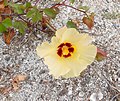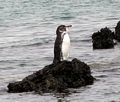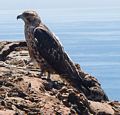
Galapagos 2012 with Exodus
This is the story of my trip to the Galapagos Islands in the Pacific ocean, some 600 miles west of Ecuador, with Exodus starting and ending at Quito, the capital of Ecuador, and then land based at 4 of the Galapagos Islands.I chose this particular holiday entitled, Galapagos: In Darwin's Footsteps, as I didn't want a sea based trip as reviews mention sea sickness and we were on the islands for 12 days enabling us to see more and get to some of the lesser visited places. It has been on my wish list for a considerable while and for various reasons Chris did not want to go, so I decided it was time for me to do it without him. Sue Jackson
chris.jackson@zen.co.uk
Click on any image to enter the Gallery.
The trip started at Heathrow where I met up with 4 fellow travellers recognised by their Exodus kit bags. We flew at 8.45 am to Atlanta with Delta Airlines, then on to Quito finally arriving there about midnight absolutely shattered after being awake for 24 hours. We were met at the airport by our leader for the next 15 days, Fabian Ledesma, who took us to the Embassy Hotel in Quito.



4th November. Next morning I met up with the rest of the group who had come on separate flights. We were a total of 15 including 5 French Canadian ladies and an American lady with the group ranging in ages from mid twenties to 70. We were taken on a city tour by Fabian, and first visited Itchimbia Park for views of Quito, (1 above), then we were dropped off in the old town for a wander round cobble stone streets, plazas and several churches including Iglesia de San Francisco (2 and 3 above) and Iglesia de la Compania de Jesus, where we were not allowed to take photos. Both churches were very opulent and ornate with so much gold decoration, they were just so OTT. As it was a Sunday the plazas were full of families enjoying themselves and lots of the roads were closed to traffic as everyone takes to their bikes. Quito is the second highest capital in the world at 2850m and we were warned to take it easy because of the altitude.




5th November. We were picked up at 7.30 am. and taken to Quito airport for our flight to San Cristobal, which is the 5th largest island in the Galapagos and is the only island with fresh water and an airport in the town. We booked in to Hotel Grand MarAzul (part of Gran Hotel Paraiso Insular)at Puerto Baquerizo Moreno, the official capital of the archipelago situated in Wreck Bay to the south east of San Cristobal. Once a sleepy fishing port it is now becoming a tourist town with a few shops. hotels and restaurants along the waterfront. After dumping our cases at the hotel Fabian took us to a nearby restaurant for lunch, and while it was being cooked he suggested we go over the road to look at the wild life. We couldn't believe our eyes at all we saw, pelicans (1 above), blue footed boobies (2 above), sea lions (3 above), great blue heron (4 above),frigate birds, finches, yellow warblers and Sally Lightfoot crabs. The sea lions were everywhere on the waterfront, totally unconcerned that they were in the way on the footpath and lazing on the benches. After lunch we were taken by our local guide, Jorge, to the visitors' centre and from there walked to the cliffs at Las Tijeteras, where we saw frigate birds in the trees, then at nearby Darwin's Cove several of the group snorkelled from the rocks and then walked to the statue of Darwin overlooking it, as this is where he first landed.





6th November. At 7.30 am. we were met by bus and taken to the highlands of San Cristobal to El Junco Lake (1 above) which was often in mist, the garua. It cloaks the islands at a height of about 300-600m during the cool, dry period from July to December. We saw in this area Miconia, an endemic shrub (in foreground of 1 above) which has almost been wiped out by human activity and fires and needs protection as well as the animals. There were also quite a few smaller flowers and frigate birds which wash in the fresh water of the lagoon to remove the salt from their feathers, they perform an interesting display as they shake their tails and Fabian said we were very lucky to see it as he had only seen it on very few occasions. From here we went to a 'galapaguera' where many of the giant Galapagos tortoises (2 above) live free in a breeding reserve in a habitat closely resembling their natural habitat. There are 10 subspecies of tortoises from the different islands, but the main differences are the saddlebacks and dome shaped. These were the saddleback species and had long necks which enabled them to reach the lower branches of trees for food. They are able to eat Manzanillo/poison apple, Hippomane mancinella, and we were warned not to touch any part of this tree as it is poisonous. We next went to the beautiful bay of Puerto Chino, where it was too rough to snorkel, but we all had fun playing in the waves . After working up an appetite we went to an organic farm for lunch and a conducted tour of the veg and flowers (3 and 4 above). Fully replete we were taken to Loberia for another swim and we saw turtles, tropical fish and sea lions with young on the beach.
7th November. A beautiful hot and sunny day spent travelling by boat on the west coast of San Cristobal. First we went to Isla Lobos where we swam with playful young sea lions, a fantastic experience, then we sailed to Kicker Rock (5 above), an impressive lava tuft formation also known as Leon Dormido as it looks like a sleeping lion from one side. The plan was to swim between the 2 rocks and the boat pick us up on the other side, but the sea was quite rough and I chickened out though a few of the group went with Fabian and Jorge, but were not able to make the trip through due to strong currents so they returned. Kate was excited that she had spotted dolphins while snorkelling, only to be told they were in fact sharks which she was pleased she hadn't known at the time. We were then taken to Puerto Grande, a sandy bay in clear calm waters for some easier swimming. That evening we went to a different restaurant recommended by Jorge and used by the locals, it was the best meal of the holiday - a huge BBQ of lobster and 2 different steaks. Unfortunately I hadn't brought my camera to capture it.






8th November. We went by a small fast boat on a 3 hour trip to the island of Floreana, which is south west of San Cristobal and is the sixth largest of the islands. The crossing was a bit rough and a few suffered from the dreaded mal de mer. We stayed at the Wittmer Hotel, the only one on the island, and it is run by 2 German ladies whose family have run the hotel for several generations. It is in an idyllic spot on the beach. (3 above) sunset from the hotel. It is a great place to see the red sea iguanas (2 above) and sea lions (1 above). After lunch we went on a walk to a nearby black volcanic beach and headland (4 above). The prevalent plant here was sea purslane or carpetweed, Sesuvium, which turns red in the dry season.
9th November. In the morning we went on a short trip to the highlands of Floreana to see one of the few sources of fresh water in the archipelago and to visit the lava caves once used by pirates who based themselves on the islands. We saw a large carved head reminiscent of those on Easter Island, but this was carved by one of the Wittmer family. Late morning we took a 2 hour boat trip to the island of Isabela. This is the largest island and is shaped like a sea horse. We disembarked at Puerto Villamil at the south end of the island and made our way to the Wooden House Hotel. After lunch at a local restaurant we went on an afternoon sail out to the islets with our new local guide, Fausto. We landed on Las Tintoreras where we saw white tipped sharks (above 5) and schools of young sea iguanas (above 6) and Galapagos penguins.





10th November. Our vehicle was loaded up with equipment and water and we were driven for an hour into the highlands of Isabela to the entrance of the Sierra Negra National Park at 700m. The Sierra Negra caldera has a diameter of 9 km and is the second largest in the world. We walked on the east side of the caldera towards Volcan Chico and here the landscape looked like something on the moon (1 above), sometimes with black lavas and in other places the colours of the rocks were like an artist's pallet. We returned the same way to the park entrance and headed through the garua to our tents which had been set up while we trekked. There were toilets in the vicinity, but little else and as the rain set in we made our way to the dining tent for our evening meal.
11th November. We awoke to rain and set off on our trek westwards eventually coming out of the mist after about 4 hours to lunch at the chosen point for our next camp which was very basic and close to the rim of the crater at 900m, . All our gear was being transported by horse to this point and was erected while we went into the crater to see the fumeroles of Volcan Azufre. As we approached (3 above) the cloud cleared showing beautiful blue skies and the nearer we got to the fumaroles we had to cover our faces to prevent inhaling the fumes, but the yellow vista was gob-smacking (4 above).The day's walk was approx. 16 km. Back at camp the rain returned that evening.
12th November. We awoke to brilliant sunshine and stunning views across the crater (5 above ) which we had not seen the previous day. On our way back to the park entrance we passed quite a few flowers and shrubs including the orchid (2 above). We rejoined our vehicle and were driven to the Giant Tortoise Breeding Centre where Fausto showed us round and explained how the eggs were collected and hatched in controlled conditions and we saw tortoises from 1 year to a lot older and bigger. In the vicinity there were lagoons where we saw flamingoes and black-necked stilt.





13th November. In the morning we picked up mountain bikes and cycled the 7 km to the Muro de las Lagrimas, Wall of Tears, (1 above) a 100m long wall of lava rocks built by convicts under harsh and abusive conditions. The penal colony closed in 1959 but this is a sad reminder of Isabela's very different past. There were lots of lava lizards (2 above) running around here. On our way back to the town we stopped off for a short walk through the 4 different types of mangroves to a small beach, but did not linger here as lunch was calling at a nearby restaurant on the main beach. During lunch Fausto offered to take any of the group for $10 each on his boat to a nearby island which was good for snorkelling and 7 of us took him up on the offer. On the way we passed Galapagos penguins (4 above) and sea lions "in charge" of boats (3 above) and this area proved to be one of the best for sea life as we saw turtles, rays, white tipped shark and the numerous tropical fish while snorkelling.
14th November. A bumpy 2 hour boat trip to the island of Santa Cruz and to the Hotel Fernandina at Puerto Ayora, which is the largest and most developed town in the Galapagos. This came as a bit of a shock as the main street was dug up and there were lots of knick-knack shops and restaurants, it seemed as if we had reached civilisation after our previous islands. On the way to the hotel we passed the fish market where pelicans, (5 above), lava gulls and frigate birds fought for scraps of fish. In the afternoon we were taken first to Los Gemelos, The Twins, empty magma chambers that collapsed in on themselves due to the weight of the overlying rocks. From here we went to the El Chato Tortoise Reserve where tortoises wander freely and where some of them weigh up to 300 kg. and finally a short visit to one of the many lava tunnels on Santa Cruz.





15th November. An early start and we were bussed to the other side of the island to a very nice boat where we had breakfast and later lunch. It was a 2 hour trip to the island of Bartolome,( 1 above) situated in Sullivan Bay off eastern Santiago island. We disembarked and saw lots of Sally Lightfoot crabs (3 above) on the rocky landing and our guide led us up the track to the summit of Bartolome pointing out lava cactus which grow on the bare lava cones. We were lucky enough to be visited by a young Galapagos hawk ( 2 above) which posed very conveniently for us for about 10 minutes. Back to the boat and a short trip to a pleasant sandy beach for swimming or sunbathing, then our return journey back to Santa Cruz. On our way we were fortunate enough to see manta rays jumping out of the sea and flipping over several times and landing with a loud belly flop which may be an attempt to shake off parasites. Fabian had told us about this and had demonstrated with a table napkin, but none of us believed him so we all shrieked with excitement when we saw it happening.
16th November. Up at 6 am for a visit to the Charles Darwin Research Centre where there is a captive breeding program for giant tortoises which are later released on to their home islands. This is where Lonesome George had lived and failed to reproduce until his death earlier in the year. We saw his epitaph. Also at the reserve we saw land iguanas which we had not seen wild on the islands. After this we travelled to the north of the island to the airport and flew back to Quito.
17th November. The coach arrived at 6 am. to take us to Otavalo, a small town famous for its traditional handicraft markets and to see the local Otavalo Indians in their traditional dress. Due to an advertised religious procession which would block the main road we took a detour and visited a monument on the equator (4 above). We were allowed 2 hours to shop at the market (5 above) and visit the sights of Otavalo including the cathedral, and we (mostly the women) came back laden with presents, alpaca jumpers, t-shirts etc.. et. and wondering how all these things were going to fit into our cases. We should have been visiting the Parque Condor next, but due to the anticipated road closure we wanted to get back to Quito ASAP, so we sadly missed it. Instead we went to Museo Guayasamin the former home of the legendary painter Oswaldo Guayasamin. His works are very reminiscent of those by Picasso.
Written and composed by Sue Jackson
chrisandsue59@gmail.com
